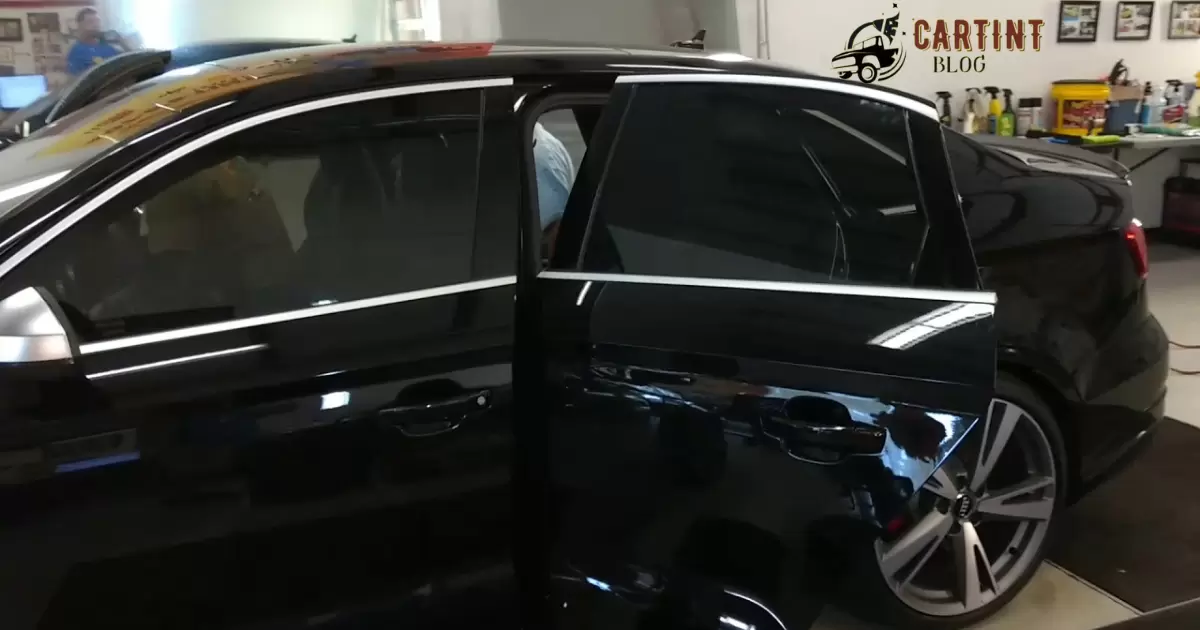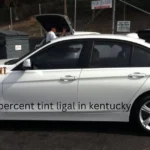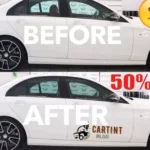Carbon Window Tinting Carbon window tint, an improvement over metalized window films, incorporates carbon particles into the film. This window tint has a distinct matte appearance, rejects more heat than metalized, and doesnt interfere with phone signals.
Ever wondered how to achieve that stylish, mysterious look for your car windows? Enter Carbon Tint, the secret weapon for a sleek and cool ride. This advanced window film not only adds a touch of sophistication to your vehicle but also shields you from the suns harmful rays.
A Carbon Tint for cars is more than just an aesthetic upgrade. Its a practical solution. Beyond its chic appearance, this tinting method offers superior heat reduction, keeping your cars interior cool even in scorching weather. It acts as a reliable UV blocker, safeguarding your skin and upholstery. Upgrade your driving experience with the perfect blend of style and functionality.
What Is A Carbon Tint?
A carbon tint for cars, commonly known as carbon window film, is a type of automotive window tint that incorporates carbon particles into the film. This results in enhanced heat and UV ray rejection, providing a cooler interior and protecting occupants from harmful sun rays.
Carbon tints also offer increased durability, reducing the likelihood of fading or discoloration over time. When considering carbon tints, its crucial to note that they usually block a significant percentage of infrared IR radiation, contributing to better heat reduction compared to standard window films.
How Is Carbon Tints For Windows Made?
To put it simply, carbon particles are blended into the film to create carbon window tint. Particularly the heat producing infrared radiation from the sun is absorbed by these particles.
As a result, a car with windows tinted with carbon will absorb less heat energy, keeping the interior colder. Carbon tint not only lowers heat transmission but also visible light transmission, so there are less glares to divert your attention when driving.
1. Carbon Particle Preparation
Carbon tints for car windows begin with the preparation of carbon particles. These particles are finely ground and processed to ensure uniformity and optimal dispersion throughout the tinting film.
2. Film Manufacturing
The carbon particles are integrated into the tint film during the manufacturing process. This step involves combining the prepared carbon particles with the raw materials of the tint film. The mixture is then processed to create a consistent and high quality tinting material.
3. Layer Application
The carbon infused tint film is applied in layers to achieve the desired level of darkness and performance. This step ensures that the carbon particles are evenly distributed within the film, providing a sleek appearance and maximizing the tints effectiveness in reducing glare and blocking harmful UV rays.
4. Cutting and Shaping
Once the tint film has been infused with carbon particles, it is cut and shaped to fit the specific dimensions of car windows. Precision in this step is crucial to ensure a perfect fit and seamless application.
5. Quality Assurance
Before reaching the market, carbon tints undergo rigorous quality control measures. Manufacturers conduct thorough inspections to guarantee that the tint film meets industry standards for durability, heat rejection, and visible light transmission.
6. Installation
Car owners can then have the carbon tint professionally installed on their vehicle windows. The installation process involves careful application of the tint film to each window, providing the desired aesthetic appeal, enhanced privacy, and improved heat management within the vehicle.
By following these steps, manufacturers create carbon tints that not only meet legal regulations but also offer a stylish and functional solution for car window tinting.
What Are The Benefits Of A Carbon Tints?
Carbon tints for cars offer numerous benefits. Firstly, they provide exceptional heat rejection, blocking a significant amount of solar heat and keeping the cars interior cool. This not only enhances driving comfort but also reduces the strain on the vehicles air conditioning system, resulting in improved fuel efficiency.
Benefits of Carbon Tints for Cars
- Exceptional Heat Rejection
Carbon tints effectively block solar heat, ensuring a cooler interior and reducing the strain on the cars air conditioning system, leading to improved fuel efficiency.
- UV Ray Protection
These tints provide excellent protection against harmful UV rays, safeguarding the cars occupants and preventing damage to the interior components, such as fading and deterioration.
- Enhanced Privacy
Carbon tints reduce visibility into the car, offering improved privacy for the occupants and adding an extra layer of security for personal belongings.
Investing in carbon tints not only enhances driving comfort but also contributes to the long term well being and preservation of your vehicle.
Is Carbon Tints Worth The Money?
Carbon tints for cars are indeed worth the money for several reasons. Firstly, they provide effective UV protection, reducing the harmful effects of sun exposure on both the cars interior and its occupants.
Carbon tints also excel in heat rejection, keeping the car cooler during hot weather, which can contribute to improved fuel efficiency by reducing the need for air conditioning.
Carbon window tint film is a better choice than tinted or metallic window tint films. Carbon is more durable, does not fade, and wont block cell phones or GPS signals like metal film can. Carbon also blocks 40% more UV rays than tinted or metal window film blocks.
Is Carbon Tints Legal
Carbon tints for cars are legal in many places, but its crucial to check local regulations. In the United States, for instance, tinting laws vary by state.
Some states have restrictions on the darkness of tinted windows, measured as a percentage of light allowed through. Its advisable to research and adhere to specific regulations to avoid legal issues.
Is Carbon Tints Better Than Regular Tint?
Carbon is a more effective window tint than tinted and metallic window tints. Best of all, it does not contain metallic materials, meaning it wont interfere with cell phones and radio transmissions.
Carbon window tint film comes with a matte finish, giving your windows an attractive look.
What Is The Benefit Of Carbon Tints?
Carbon tints for cars offer numerous benefits. Firstly, they provide superior UV protection, blocking harmful rays that can damage your skin and fade your cars interior. In addition to UV resistance, carbon tints excel in heat rejection, keeping your vehicle cooler and reducing the need for excessive air conditioning, which can improve fuel efficiency.
Reduced glare
Carbon tint is effective in reducing glare from the sun and other bright light sources. It can increase visibility and reduce eye strain, making your driving experience safer and more enjoyable, especially on bright sunny days or when driving at night.
Better privacy
Carbon tint increases privacy by making it difficult for others to see inside your car. This creates a dark, opaque look on the outside while allowing good visibility on the inside. This can deter potential thieves and provide a greater sense of security.
Denial of heat
Carbon tint is known for its excellent heat rejection properties. This can help improve fuel efficiency by reducing reliance on air conditioning.
How Long Does Carbon Tints Last?
The fading process also depends on the material in the film. Poor quality films will fade in a few days in the hot sun. Carbon and ceramic films last longer, five to ten years. Films with standard colors and metal deposits can last 10 to 20 years.
Budget Friendly Carbon Tints
Discover budget friendly carbon tints for cars, an affordable solution that enhances both style and functionality. These tints not only provide a sleek appearance but also offer superior UV protection, reducing interior heat by up to 60%. With prices starting at $75, its an economical choice without compromising quality.
Focused on performance, our carbon tints boast a 99% UV rejection rate and 50% heat reduction, ensuring a comfortable driving experience. Available in various shades to suit individual preferences, these tints are easy to install and come with a 5 year warranty. Upgrade your cars aesthetics and comfort without breaking the bank with our budget friendly carbon tints.
Carbon Window Tinting vs Ceramic Window Tinting
Carbon window tinting and ceramic window tinting are popular choices for car owners seeking enhanced UV protection and heat rejection. Carbon tinting consists of carbon particles that offer good UV blocking and moderate heat reduction.
On the other hand, ceramic window tinting employs advanced ceramic technology, providing superior UV protection and significantly higher heat rejection compared to carbon tints.
Carbon tint gives your car a great look, while rejecting most heat and not interfering with cellular signals. The next step up, ceramic tint does everything that carbon tint does, but at higher efficiency with more UV, heat and glare reduction. So, when making a decision, you have to ask yourself if you prefer quality over price over performance.
Heres a detailed table comparing Carbon Window Tinting and Ceramic Window Tinting for cars.
| Feature | Carbon Window Tinting | Ceramic Window Tinting |
| Composition | Carbon particles | Advanced ceramic technology |
| UV Protection | Good | Superior |
| Heat Reduction | Moderate | Significantly higher |
| Performance in Heat Rejection | Good for basic needs | Excellent for maximum heat rejection |
| Electromagnetic Signal Interference | Minimal | None |
| Cost | Cost effective | Higher investment |
| Durability | Decent | Durable |
Is carbon tint any good?
Carbon tint is indeed a beneficial choice for car windows. It effectively reduces heat and UV rays, providing up to 99% UV protection.
Carbon tint minimizes glare, enhancing visibility and comfort for drivers and passengers.
Its durable composition ensures long lasting performance, making it a reliable investment for maintaining a cooler and more secure interior.
Is ceramic tint darker than carbon?
The main difference between these types of films is, as the name suggests, in the content.
The carbon particles give the film pigmentation, so it looks darker and does a great job of reducing glare.
FAQs
Is carbon tint better than regular tint?
Carbon tint is often considered superior to regular tint due to its enhanced heat rejection and UV blocking properties.
How do you know if you have carbon tint?
Identifying carbon tint involves checking for specifications on the tint film packaging or consulting the vehicle manufacturer for information on the installed tint type.
Does carbon tint reduce heat?
Yes, carbon tint is known for its effective heat reduction capabilities, making it a popular choice for enhancing comfort inside vehicles.
Carbon window tint percentages?
The darkness of carbon window tint varies, and its measured by the Visible Light Transmission VLT percentage, with lower values indicating a darker tint.
What is a carbon tint cost?
The cost of carbon tint installation depends on factors like the vehicle type and the specific brand or quality of the tint prices vary, so its advisable to obtain quotes from tinting professionals.
Conclusion
In essence, a carbon tint for cars serves as a high performance window film designed to enhance both aesthetics and functionality. By incorporating carbon particles into the tint material, it not only achieves a sleek, dark appearance but also offers notable benefits.
Primarily, carbon tints excel in reducing heat and blocking harmful UV rays, contributing to a cooler and more comfortable interior. The technology behind carbon tints allows for optimal heat rejection without compromising visibility.
These tints often come in various percentages, allowing vehicle owners to choose the darkness that suits their preferences. In conclusion, a carbon tint for cars is a practical and stylish solution, seamlessly marrying visual appeal with effective heat management and UV protection for an overall improved driving experience.



